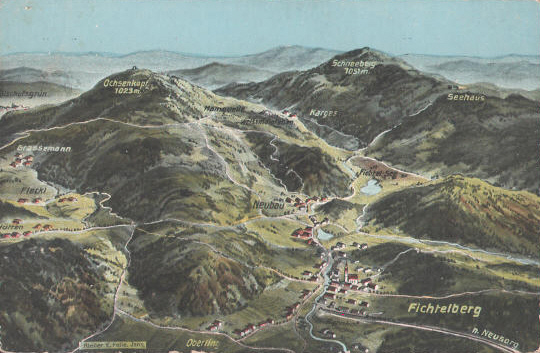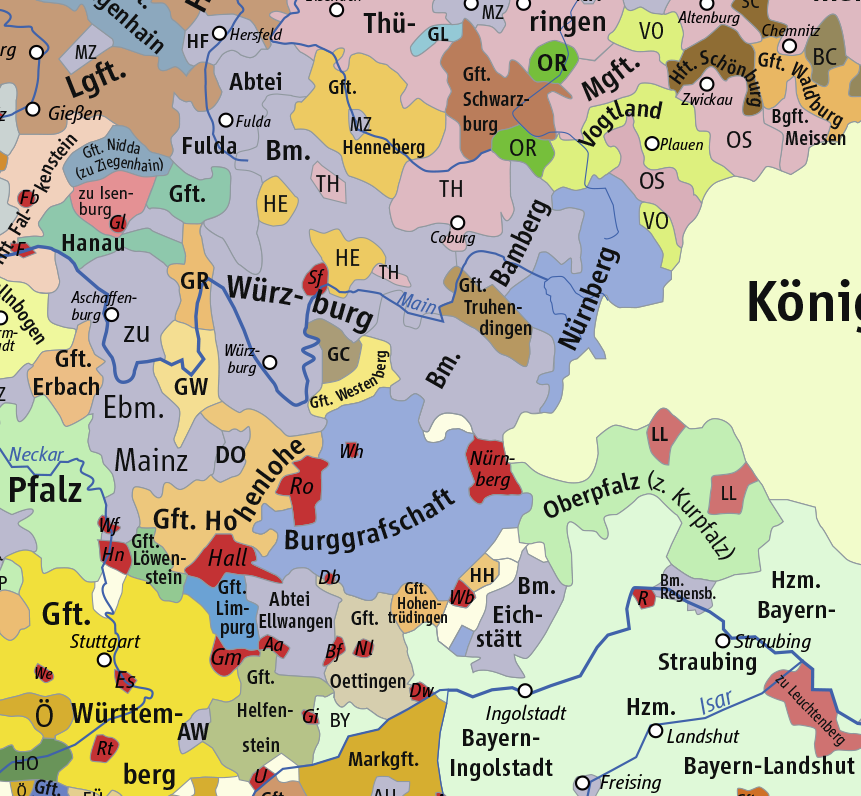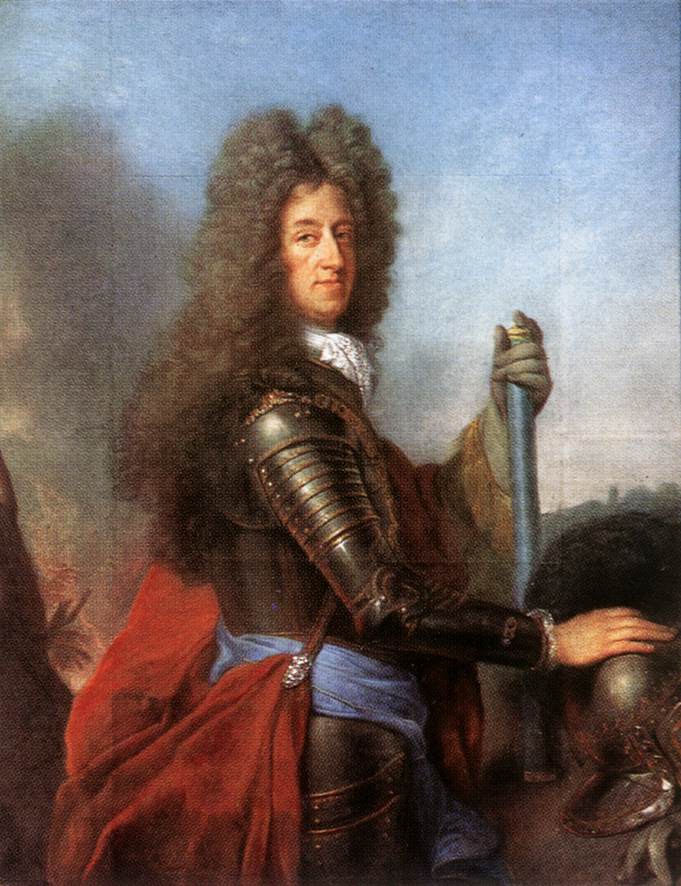|
Fichtelberg, Bavaria
Fichtelberg () is a municipality in the district of Bayreuth in Bavaria in Germany. It is a state-recognised climatic spa (Luftkurort). Geography Fichtelberg lies on the southeastern slopes of the Ochsenkopf, the second highest summit of the Fichtel Mountains, and the most populous place in the Fichtel Mountain Nature Park. Fichtelberg lies on a major European watershed. Two rivers rise above the suburb of Neubau, the White Main, one of the two headstreams of the Main, which flows westwards to the Rhine, and the Fichtelnaab, which flows south and enters the Danube. Since 1857 Fichtelberg has belonged to the Bavarian provinces of Upper Franconia. Municipal divisions * Fichtelberg * Hüttstadl * Neubau Neighbouring parish The only parish that borders immediately on Fichtelberg is Mehlmeisel. Etymology The origin of the name Fichtelberg, as well as the Fichtel Mountains is probably to be found in mining lore and not, as long suspected, its dense, spruce forests. At th ... [...More Info...] [...Related Items...] OR: [Wikipedia] [Google] [Baidu] |
Danube
The Danube ( ; see also #Names and etymology, other names) is the List of rivers of Europe#Longest rivers, second-longest river in Europe, after the Volga in Russia. It flows through Central and Southeastern Europe, from the Black Forest south into the Black Sea. A large and historically important river, it was once a frontier of the Roman Empire. In the 21st century, it connects ten European countries, running through their territories or marking a border. Originating in Germany, the Danube flows southeast for , passing through or bordering Austria, Slovakia, Hungary, Croatia, Serbia, Romania, Bulgaria, Moldova, and Ukraine. Among the many List of cities and towns on the river Danube, cities on the river are four national capitals: Vienna, Bratislava, Budapest, and Belgrade. Its drainage basin amounts to and extends into nine more countries. The Danube's longest headstream, the Breg (river), Breg, rises in Furtwangen im Schwarzwald, while the river carries its name from its ... [...More Info...] [...Related Items...] OR: [Wikipedia] [Google] [Baidu] |
Baroque
The Baroque ( , , ) is a Western Style (visual arts), style of Baroque architecture, architecture, Baroque music, music, Baroque dance, dance, Baroque painting, painting, Baroque sculpture, sculpture, poetry, and other arts that flourished from the early 17th century until the 1750s. It followed Renaissance art and Mannerism and preceded the Rococo (in the past often referred to as "late Baroque") and Neoclassicism, Neoclassical styles. It was encouraged by the Catholic Church as a means to counter the simplicity and austerity of Protestant architecture, art, and music, though Lutheran art#Baroque period, Lutheran Baroque art developed in parts of Europe as well. The Baroque style used contrast, movement, exuberant detail, deep color, grandeur, and surprise to achieve a sense of awe. The style began at the start of the 17th century in Rome, then spread rapidly to the rest of Italy, France, Spain, and Portugal, then to Austria, southern Germany, Poland and Russia. By the 1730s, i ... [...More Info...] [...Related Items...] OR: [Wikipedia] [Google] [Baidu] |
Putti
A putto (; plural putti ) is a figure in a work of art depicted as a chubby male child, usually naked and very often winged. Originally limited to profane passions in symbolism,Dempsey, Charles. ''Inventing the Renaissance Putto''. University of North Carolina Press, Chapel Hill and London, 2001. the putto came to represent a sort of baby angel in religious art, often called a cherub (plural cherubim), though in traditional Christian theology a cherub is actually one of the most senior types of angel. The same figures were also seen in representations of classical myth, and increasingly in general decorative art. In Baroque art the putto came to represent the omnipresence of God. A putto representing a cupid is also called an amorino (plural amorini) or amoretto (plural amoretti). Etymology The more commonly found form ''putti'' is the plural of the Italian word ''putto''. The Italian word comes from the Latin word ''putus'', meaning "boy" or "child". Today, in Italian, '' ... [...More Info...] [...Related Items...] OR: [Wikipedia] [Google] [Baidu] |
Freie Wähler
Free Voters (, FW) is a political party in Germany. It originates as an umbrella organisation of several Free Voters Associations (), associations of people which participate in an election without having the status of a registered party. These associations are usually locally-organised groups of voters in the form of a registered association (eV). In most cases, Free Voters campaign only at local government level, standing for city councils and for mayoralties. Free Voters tend to achieve their most successful electoral results in rural areas of southern Germany, appealing most to conservative voters who prefer local decisions to party politics. Free Voter groups are active in all of the states of Germany. History In the 2003 Bavaria state election, the FW association received 4.0% of the vote (411,306 votes), barely missing the 5% threshold required to enter the state Landtag. In the 2008 Bavaria state election, the FW association received 10.2% of the vote and gained th ... [...More Info...] [...Related Items...] OR: [Wikipedia] [Google] [Baidu] |
Christian Social Union Of Bavaria
The Christian Social Union in Bavaria (German language, German: , CSU) is a Christian democracy, Christian democratic and Conservatism in Germany, conservative List of political parties in Germany, political party in Germany. Having a regionalism (politics), regionalist identity, the CSU operates only in Bavaria while its larger counterpart, the Christian Democratic Union of Germany, Christian Democratic Union (CDU), operates in the other fifteen states of Germany. It #Relationship with the CDU, differs from the CDU by being somewhat more conservative in social matters, following Catholic social teaching. The CSU is considered the ''de facto'' successor of the Weimar Republic, Weimar-era Catholic Bavarian People's Party. At the federal level, the CSU forms a common faction in the Bundestag with the CDU which is frequently referred to as the Union Faction (''die Unionsfraktion'') or simply CDU/CSU. The CSU has had 43 seats in the Bundestag since the 2021 German federal election, ... [...More Info...] [...Related Items...] OR: [Wikipedia] [Google] [Baidu] |
Blick über Den Fichtelsee (von Süden)
''Blick'' (View) is a Swiss German-language daily newspaper and online news website covering current affairs, entertainment, sports and lifestyle. Based in Zurich, it is the largest newspaper in Switzerland with a print circulation of around 285,000. The newspaper has been printed continuously since its inception in 1959. History and profile ''Blick'' was established in 1959. The newspaper was the first Swiss tabloid publication. The format of ''Blick'' was broadsheet until 2005 when it was switched to tabloid. The new format induced controversies: protests began and many boycotted the scandalous newspaper. It was nevertheless a huge financial success. However, in 2009 the daily changed its format to broadsheet. Its sister paper was from 2008–2018 ''Blick am Abend'', an evening free daily. Both papers are owned by Ringier and are based in Zürich. Ladina Heimgartner was appointed as CEO in October 2020. In August 2023, Christian Dorer stepped down as Editor-in-Chief after a ... [...More Info...] [...Related Items...] OR: [Wikipedia] [Google] [Baidu] |
Gablonz
Jablonec nad Nisou (; ) is a city in the Liberec Region of the Czech Republic. It has about 46,000 inhabitants. It is the second-largest city in the region. It is a local centre for education, and is known for its glass and jewelry production, especially for bijou. The historic town centre is well preserved and is protected as an urban monument zone. Administrative division Jablonec nad Nisou consists of eight municipal parts (in brackets population according to the 2021 census): *Jablonec nad Nisou (25,274) *Jablonecké Paseky (2,550) *Kokonín (1,985) *Lukášov (272) *Mšeno nad Nisou (8,428) *Proseč nad Nisou (2,056) *Rýnovice (2,540) *Vrkoslavice (1,381) Etymology The name ''Jablonec'' is of Czech origin and means 'little apple tree' (''jablonče'' was a diminutive of the old Czech ''jabloň'' – 'apple tree'), for the village was founded on a place where an apple tree grew. German-speaking settlers who came to the village during the 16th century adjusted the name to '' ... [...More Info...] [...Related Items...] OR: [Wikipedia] [Google] [Baidu] |
Margrave Of Bayreuth
The Principality of Bayreuth () or Margraviate of Brandenburg-Bayreuth (''Markgraftum Brandenburg-Bayreuth'') was an immediate territory of the Holy Roman Empire, ruled by a Franconian branch of the Hohenzollern dynasty. Since Burgrave Frederick VI of Nuremberg was enfeoffed with the Margraviate of Brandenburg in 1415/17, the Hohenzollern princes transferred the margravial title to their Franconian possessions, though the principality never had been a march. Until 1604 they used Plassenburg Castle in Kulmbach as their residence, hence their territory was officially called the Principality of Kulmbach or Margraviate of Brandenburg-Kulmbach until the Empire's dissolution in 1806. Geography The Kulmbach-Bayreuth principality arose from the northern uplands (''Oberland'') of the former Burgraviate of Nuremberg, while the southern lowlands (''Unterland'') formed the Principality of Ansbach. The final border demarcation was settled by the 1541 House Treaty of Regensburg, adding so ... [...More Info...] [...Related Items...] OR: [Wikipedia] [Google] [Baidu] |
Kingdom Of Bavaria
The Kingdom of Bavaria ( ; ; spelled ''Baiern'' until 1825) was a German state that succeeded the former Electorate of Bavaria in 1806 and continued to exist until 1918. With the unification of Germany into the German Empire in 1871, the kingdom became a federated state of the new empire and was second in size, power, and wealth only to the leading state, the Kingdom of Prussia. The polity's foundation dates back to the ascension of Elector Maximilian IV Joseph of the House of Wittelsbach as King of Bavaria in 1806. The crown continued to be held by the Wittelsbachs until the kingdom came to an end in 1918. Most of the border of modern Germany's Free State of Bavaria was established after 1814 with the Treaty of Paris, in which the Kingdom of Bavaria ceded Tyrol and Vorarlberg to the Austrian Empire while receiving Aschaffenburg and Würzburg. In 1918, Bavaria became a republic after the German Revolution, and the kingdom was thus succeeded by the current Free State of Ba ... [...More Info...] [...Related Items...] OR: [Wikipedia] [Google] [Baidu] |
Electorate Of Bavaria
The Electorate of Bavaria () was a quasi-independent hereditary electorate of the Holy Roman Empire from 1623 to 1806, when it was succeeded by the Kingdom of Bavaria. The Wittelsbach dynasty which ruled the Duchy of Bavaria was the younger branch of the family which also ruled the Electoral Palatinate. The head of the elder branch was one of the seven prince-electors of the Holy Roman Empire according to the Golden Bull of 1356, but Bavaria was excluded from the electoral dignity. In 1621, Frederick V, Elector Palatine was put under the imperial ban for his role in the Bohemian Revolt against Ferdinand II, Holy Roman Emperor, and the electoral dignity and territory of the Upper Palatinate was conferred upon his loyal cousin, Duke Maximilian I of Bavaria. Although the Peace of Westphalia would create a new electoral title for Frederick V's son, with the exception of a brief period during the War of the Spanish Succession, Maximilian's descendants would continue to h ... [...More Info...] [...Related Items...] OR: [Wikipedia] [Google] [Baidu] |
Steinach (Rodach)
Steinach () is a river of Thuringia and Bavaria, Germany. Its source is near Neuhaus am Rennweg, and it flows to the south, passing through the towns Steinach and Sonneberg. It is a right tributary of the Rodach, which it joins near Redwitz an der Rodach. It is a popular hiking area for locals, as well. See also *List of rivers of Thuringia *List of rivers of Bavaria A list of rivers of Bavaria, Germany: A * Aalbach * Abens * Ach * Afferbach * Affinger Bach * Ailsbach * Aisch * Aiterach * Alpbach *Alster * Altmühl * Alz * Amper * Anlauter * Arbach * Arbachgraben * Aschaff * Aschbach * Attel * Aubach, tributa ... References Rivers of Thuringia Rivers of Bavaria Kronach (district) Coburg (district) Lichtenfels (district) Sonneberg (district) Rivers of Germany {{Thuringia-river-stub ... [...More Info...] [...Related Items...] OR: [Wikipedia] [Google] [Baidu] |






